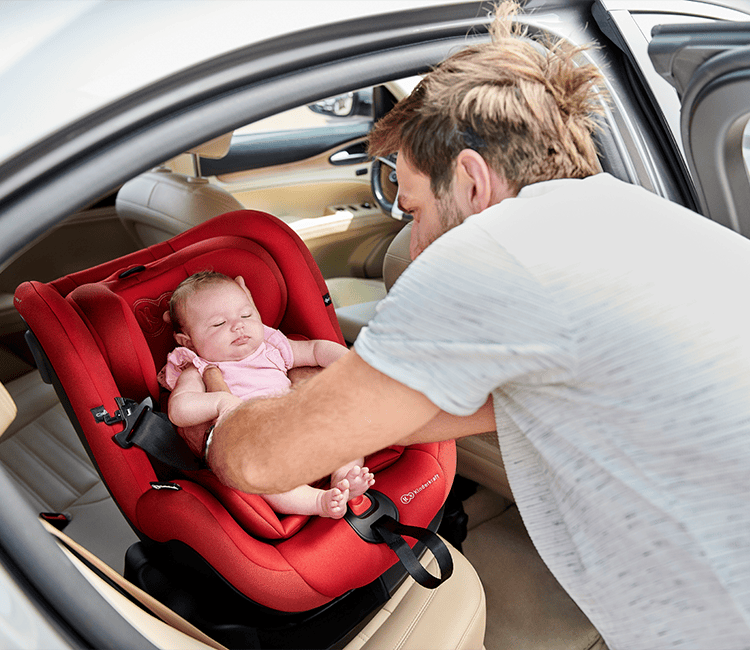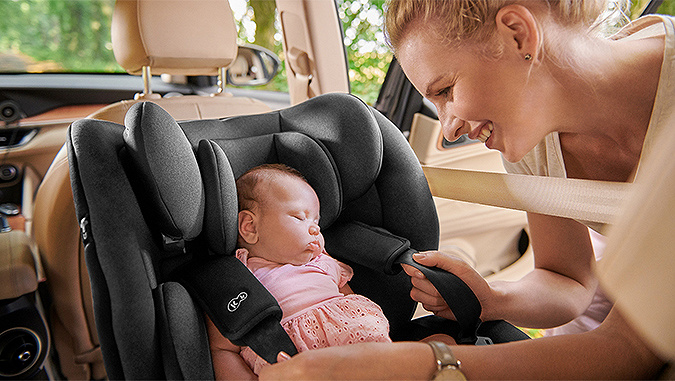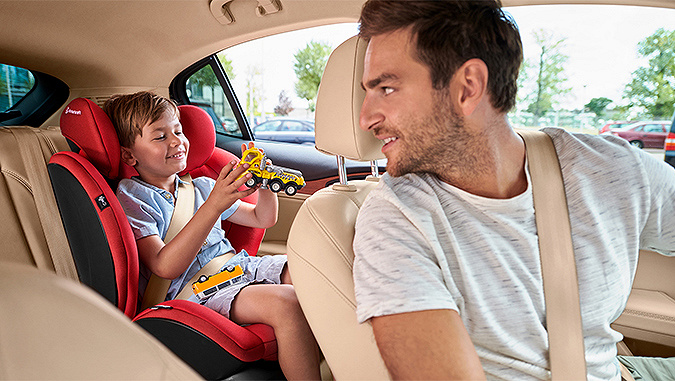Car seat for babies and newborns - from when? Which one to choose?
7 min

Few people realize that a car seat is one of the first purchases for a newborn baby - it's essential for the ride home from the hospital. But every parent wonders: what kind of car seat will be best for my baby? The answer to this question is simple - safe. But what does it mean? Unfortunately there is no simple answer to this question. But don't worry - step by step we will help you to choose the best car seat for your child.
Why you should use a child car seat - the rules for transporting children in the car
Isn't it true that your little one will be safer anywhere than in your arms? True - as long as you don't drive. Believe me, while driving a car seat is a much more appropriate place for him or her. Carrying a child in a car seat protects the child comprehensively. First of all it guarantees safety in case of side collisions and at the same time it reduces the risk of a small passenger diving under the belt during head-on collisions.
The traffic laws are clear: you cannot transport children without a proper car seat. What's more, the child seat must be properly installed. This means that it cannot be transported loose or inaccurately fastened. It is necessary to press it properly to the sofa, so that it does not swing from side to side and the child along with it. A well-fitted car seat is one that is stable and sturdy.
How long can you use the car seat
Until recently there was a legal regulation in Poland saying that a parent is obliged to transport children under the age of 12 in a car seat. For some time the law says otherwise. Now it doesn't matter how old the child is - only its height matters. All children, who are less than 150 cm tall, must ride in a car seat. There is only one small exception to this rule - when the child grows out of the weight limit (36 kg) and is at least 135 cm tall.
Carrying children in the car in other countries
It's also worth knowing - especially if you're planning on travelling further afield with your little one - that there may be different rules on taking children in the car abroad, which you need to comply with. What does it look like in Germany, France, Spain, Italy and the UK? Here is our quick guide.
Regulations in Germany
In Germany it is compulsory to transport children up to the age of 3 in child safety seats. This law applies until the child is 12 years old or 150 cm tall.
Regulations in France
In France, children up to the age of 3-4 must be transported in car seats, and older children, up to the age of 10, should ride in a car seat or a special seat. Older children are required to ride with a seatbelt adjusted to their height.
Rules in Spain
In Spain, regulations state that children must be transported in car seats adapted to their height until they are 12 years old and at least 135 cm tall.
Rules in Italy
In Italy, when transporting children in the car, their age does not matter. As in Poland, only their height matters. The child must ride in a car seat or on a special platform seat until it reaches 150 cm.
Regulations in the United Kingdom
In the UK, only the height of children counts, not their age. They must be carried on special platforms or in car seats until they are 135 cm tall.

Seat types
The first time you come across a car seat it can make your head spin. How many colors, functions, sizes, fasteners! How to catch up with it? Don't panic - we already explain everything. In our guide you will find out: what weight categories are available on the market, what are the fitting options, how to fit the car seat to your car, what are the additional safety features and what to consider when choosing the best child car seat. In addition, we describe the most important safety tests, such as ADAC or Stiftung Warentest, we explain a number of terms such as ISOFIX system, RWF or TOP TETHER belt, we convince you that it is not worth using second-hand car seats and show you the risks involved.
Seat categories - weight categories
First of all, you should determine how much your child weighs. If you already know that, have a look at the car seat categories, because they are differentiated according to the weight of babies. Generally car seats are divided into 5 weight groups:
- Group 0 (up to 10 kg);
- Group 0+ (up to 13 kg);
- Group I (9 to 18 kg);
- Group II (15 to 25 kg);
- Group III (22 to 36 kg).
You will probably say: I have seen car seats with other weight ranges with my own eyes! It's true - there are even some that can accompany your child from the first trip until it is 150 cm tall! They combine different weight categories and allow you to change seats less often. It's certainly a more economical solution, and such car seats adapt well to the body of growing children thanks to appropriate adjustments.
When to switch to a larger car seat? When should my child switch to another car seat?
How can you be sure that it is time to change the child seat in the car? First of all, it is not always worth rushing. Especially in the case of an infant - a baby should ride in his or her first car seat for as long as possible, that is as long as he or she reaches the weight appropriate for using child car seats from the higher group.
Moving on to the next weight categories is different - this time lingering is not advisable. The body weight of your child is still the main indicator, but it is worth paying attention to other details: the distance from the top of the head to the top of the seat and the way the shoulder straps are positioned. The rule is simple: the straps should not go under the child's shoulders. So, if the belts do not fit well the shoulders of your child - it is time for a change!

How do I fit a car seat into my car?
Another thing you should look at when choosing a car seat is your car. Not every car seat fits all cars. It is good practice - and a must! - is to try it on before making a final decision. It may turn out that the belts on the back seat are too short or the car seat does not fit the shape of the seat in your car. You can't really tell by looking, and one fitting can save you from a costly mistake.
It may also turn out that your car does not have ISOFIX system attachments, the stabilizing leg of your dream car seat is not compatible with the car, there is nothing to attach the TOP TETHER belt to, and in addition your child will not tolerate driving with the RWF option. Sounds difficult to understand? We will make it simple in a second!
How to install a car seat? Assembly methods methods
When looking around for the perfect car seat, you will come across many options. Each is worth considering. Child safety car seats can be divided by the way they are attached to the rear seat of a car. Some are installed using the car's seat belt. Others are attached using a special system called ISOFIX. The option with safety belts is more universal and allows the car seat to be fitted in any car with three-point safety belts. On the other hand, car seats with Isofix fixing systems are considered more secure and safer because they provide a more stable fixing and allow to avoid mistakes during assembly.
ISOFIX - what is it?
ISOFIX is a special system that allows the seat to be quickly and rigidly secured in the car. The seat has special ISOFIX attachments that clip into the fixings located between the seat and the back of the car seat. When choosing a car seat, be sure to check whether your car has the necessary attachments. They are standard on models made after 2013, but older cars may not have them. ISOFIX is praised mainly for its increased safety and convenience. Car seats mounted this way are more rigidly attached. Seats with ISOFIX attachments also have indicators that let you know when the seat is properly clipped in, giving you confidence that the seat is properly installed. They are also easier to install and much quicker to transfer from car to car - of course, if both are equipped with the appropriate attachments.
A stabilizing and supporting leg for a car seat - what is it?
Not all ISOFIX child seats are exactly the same. Some models are also equipped with a seat stabilizer - a special leg that rests against the floor of the car. This solution ensures greater seat stability and reduces the risk of incorrect assembly (as part of the overall ISOFIX system). The legs are telescopically adjustable in height and are equipped with a position indicator.
TOP TETHER belt - what is it?
An option that further improves safety is the TOP TETHER belt, which connects the rear part of the car seat to the fixing point on the car. The function of the TOP TETHER belt is to reduce the seat's movement around the ISOFIX fixing point in the event of an accident. As with the Isofix system, in models manufactured after 2013 this ffixing point is standard, but older cars may not have it. So be sure to check if you will be able to use this solution before making a purchase decision.
RWF - what is it and are RWF seats safer?
We are left with one more foreign-sounding name to decipher - RWF. It's nothing but an abbreviation for "rear way facing", which means the position of the child seat in the car. Why is it important? It turns out that riding rearward facing is up to five times safer for a child than riding forwards! Tests carried out by the VTI institute have proven that RWF car seats have a 92% lower risk of injury in collisions. It is recommended that children should be transported rearward facing until they are 3-4 years old. According to the ECE R44 homologation, this way children under 9 kg should be transported, and according to the i-Size standard, babies under 15 months of age.
We do not have to decide right away on a rearward or forward facing method of transporting a baby. There are also child car seats that can be installed in both directions. You can even find ones that allow you to rotate the seat thanks to a special base. This is a very helpful option - be sure to consider it! - Thanks to the base it is easier to put the child into the seat and to change its positioning in relation to the direction of travel.
Car seat certification - crash tests
The issues listed are extremely important - if you don't take them into account, you won't be happy with your choice. But there is something much more important - safety. Not every car seat gives the same guarantee of protecting the child in case of an accident. There are many institutions that subject car seats to special crash tests. Thanks to their results we know how they perform in a crash. The testing organizations do not inform the manufacturers about the qualification for the tests. Manufacturers also cannot ask to see their products. This is to ensure the independence and greater credibility of these prestigious institutions. What's interesting, seat tests are done only once, in cooperation with several institutions. Only then each of the organizers publishes them in their own way, giving their own rating.
ADAC
The most well known and prestigious is the German ADAC test, which scores car seats' behavior during an impact, but also stability of fixing, ease of installation, amount of space for a child, weight and even lack of harmful substances in the materials used. The ADAC tests are considered to be the most rigorous, that's why their results are often treated as the most important information about the quality and safety of a car seat. Tested car seats receive points: a score of 1.0-1.5 is the highest, and 4.6-5.5 is the lowest. We can boast that our ONETO3 car seat was placed on the podium of products for children in the height range 75-150 cm in the spring 2020 ranking created by this institution!
Stiftung Warentest
Slightly less popular in Poland is the Stiftung Warentest child seat testing institute. In Germany, on the other hand, almost ⅓ of those who buy a child car seat are guided by its recommendations and as many as 93% of adult Germans are familiar with this institution[1]. Stiftung Warentest evaluates general safety, but also issues such as the seat's ease of use, the content of harmful substances and ergonomics.
ÖAMTAC
The ÖAMTC is an Austrian car, motorcycle and travel club that is the local equivalent of the German ADAC. The ÖAMTC is the Austrian equivalent of the German ADAC and tests the safety of car seats, their user-friendliness, ergonomics and harmful substances.
TASS INTERNATIONAL
TASS INTERNATIONAL is a leading Dutch organisation with offices in 11 countries around the world that specialises in crash testing. All Kinderkraft brand car seats are crash tested by TASS INTERNATIONAL. They are also checked by the renowned INTERTEK laboratories for the safety of the materials used in manufacturing the upholstery. They also have the ECE R44.04 homologation certificate.
Good ratings for Kinderkraft car seats
Kinderkraft car seats are also well evaluated by prestigious industry magazines, such as German "Alle Beste", which placed the MYWAY seat in its ranking. Our child car seat received positive recommendations from parents and independent service experts.
Used car seats - is it worth it?
Buying a second-hand car seat may seem like a tempting option. However, specialists strongly advise against such a solution. Car seats have their own lifespan. The material simply wears out. When you decide to buy a second-hand one, you never know when the seat was bought and how long it was used. We also don't know if it hasn't been involved in an accident - and any seat after an accident should be taken out of use right away. Besides, the seat's padding adapts to the shape of the child's back and may not fit properly on a new owner's small body.
Summary - how to choose a car seat?
So how to find that one best car seat? There are several things to consider: the weight of the child, the assembly method and of course the test ratings - because safety is the most important thing. But remember also about the conditions of your car and your own preferences - about comfort or simply the look. From now on the car seat will accompany you on all your trips. So you have to get to know each other.
[1] https://pl.wikipedia.org/wiki/Stiftung_Warentest, 23.05.2021.
